Many years ago when I lived on Canada's West Coast I was an avid ocean kayaker and I also started reading Wooden Boat magazine. I was particularly enthralled with the strip-built sea kayaks whose photos appeared in the magazine from time to time. I wanted to build a strip boat but was turned off by the estimates of the amount of time one of those boats would require...400 to 500 hours ...and I was unsure of my ability to build anything as I have virtually no woodworking experience. I had lots of time reading woodworking magazines but no real tool time despite buying a table saw, router, router table and other hand and power tools. There always seemed to be something preventing me from getting started on a project of any description.
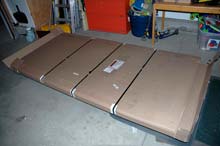 |
The beginning - Nine sheets of BS1088 Meranti Marine plywood as delivered from Noah's Marine in Ontario.
click images to enlarge |
Time passed and my wife and I had a couple of sons and in 2000 moved from the ocean back to the Canadian Prairies where we were born and raised. Three years ago, she was diagnosed with leukemia and has been in a battle ever since. We have done several things as a family because her future is still very uncertain and we don't know how long we will all have together. Last fall about this time I decided it was time I built a boat, that this was something I wanted to do and I wasn't going to wait because I don't know how long I will be around either.
| The sawhorses are ready! |
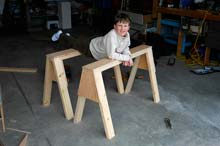 |
Before she was diagnosed I started becoming interested in the small skiffs and boats described as beach cruisers. Boats that would be capable of taking a family of four out on the water and to beach campsites. It sounded like a fun way to spend time together on the water. I've never been interested in motorboats. I don't like the noise and the smell. I prefer to be on the water in a non-motorized craft enjoying nature and this was a way for us all to travel together. Kayaking wasn't really practical as I couldn't take two kids by myself in one and my wife's ability to handle a double with a young child made me too nervous to seriously contemplate getting a couple of double kayaks. It also didn't look like there were many commercially available boats that did what these boats did so it looked like if I wanted one I would have to build it myself.
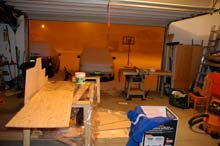 |
This is why I need heaters to cure the epoxy. |
I started searching and gathering information on the internet and wound up ordering a set of plans for Warren Jordan's "Footloose"
design that I really liked the looks of. For various reasons I decided not to build it and searched some more. I found Michael Storer's "Goat Island Skiff" (GIS) design and really liked the looks of it. Michael answered many of my questions via e-mail especially concerning the advantages of the balance lug rig that the GIS uses. I ordered a set of GIS Plans and spent a lot of time reading through Michael's instructions. Before I could order material I decided I wanted a boat with lots of flotation as it would be sailed with a couple of young boys aboard and I wanted the flotation. This also led to my discovery of Duckworks as the GIS plans were bought from the Duckworksbbs.com website.
| Gravity is your friend when fitting the bilge panels and bottom. This shows how they fall towards the bulkheads instead of away as they would if you built the boat upright. |
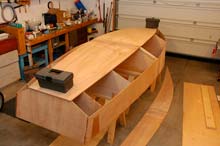 |
More time spent searching through the plans on the Duckworksbbs website and I came across the Ladybug design by Jim Michalak. Lots of built-in flotation and balance lug rig. I liked it. But what captivated me were the photos of Chuck & Sandra Leinweber's Ladybug ...the only one in existence. There was just something about the shots of Chuck and Sandra using it to camp in that captured my imagination. It looked like a boat we could have some adventures in!
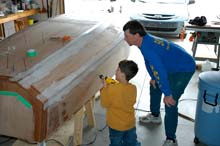 |
Cameron taking out screws from the bulkheads. |
Chuck answered many of my questions on the boat and I ordered a set of plans from him. Little did he know he would be embarking on a 7 month long question answering marathon with me!
| First half of bottom being glassed and epoxied. I covered the bottom from side/bilge joint to side/bilge joint. This went better than I expected. I did it 1/2 at a time as I was working alone and didn't know if I'd be able to keep up mixing epoxy. It wasn't a problem. The cloth smoothed out nicely and I had virtually no air bubble problems. |
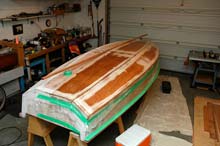 |
It took me seven months and nearly 450 hours to finish my Ladybug....which is somewhat ironic as it was the same amount of time as a strip kayak would have taken, an amount of time I felt was excessive. I figure that I have a boat for four, not one so I'm way ahead. This was double what I had expected to spend on the construction. I based that on different things I read on the internet and added some time to compensate for my lack of woodworking experience. It definitely took me longer than I expected. I really thought I would be sailing it in the summer and as it turned out I had to go at it pretty hard to get it in the water before freeze-up.
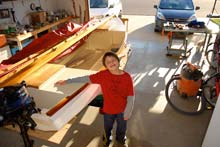 |
Cam is wondering, "When are we going to actually get this boat in the water Dad?" |
It was a great experience. Lots of problem solving figuring out how to do everything that needed doing. The only tedious part that I disliked was sanding. My goodness it was sometimes very hard to go out in the garage and sand for hours. I am completely pleased with the outcome though. I think it looks great. I love the minimal amount of varnished wood I kept on it. I feel like I can do anything with tools now given the time to plan and research what I need to do ...and have a resource like Chuck and the people on the Yahoo dwforum group who all helped me along the way.
| Mainsail up! |
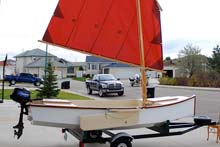 |
The launch day was just one of the best days of my life! We had to wait a couple of weeks from the time the boat was ready ...waiting for a day we could take the kids out of school when the weather was suitable ...and finally on October 17th, 2008 everything lined up. A fine October day of about 50 degrees F with low winds and partly cloudy skies. An old skydiving friend, Terry, joined us and we after I explained my reasons, I dedicated the boat to my late father and named it Ugo Igo Too. We took it out using the outboard first (ironic considering my aversion for motorboats) with just my family aboard. As none of us had never sailed before we had decided that Terry and I would put on our wetsuits and other cold water gear to sail it before we took anybody else. We were easily able to sail the boat through tacks in the light air of 6-9 mph and never felt uneasy with the handling in the winds we had. So, we went back to shore and picked up our two sons, Hunter and Cameron, and went for a sail.
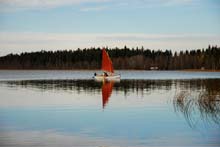 |
Sailing at last! |
I was so focused with the sailing that I didn't pay much attention to other aspects of how the Ladybug design is on the water. With no experience in sailing, neither Terry nor I had anything to compare it to but Terry made several comments on how he liked the roominess and he found it comfortable to sit in and move around in and that it felt very solid on the water. I know I came away thinking it was going to be a great boat in which to learn sailing and agreed with his assessments of the boat's characteristics.
| This picture proves the boat is big enough for the whole family. |
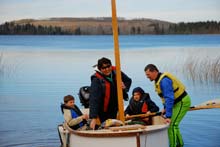 |
The part I loved the best was hearing the water making musical gurgles and tinkles as we glided over the surface. The lake is deserted at this time of year except for a handful of year round residents. A couple of loons commented on our passing but otherwise we sailed quietly listening to the water music.
***** |

